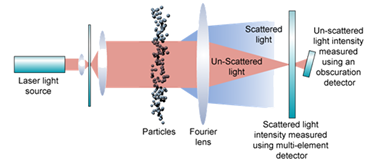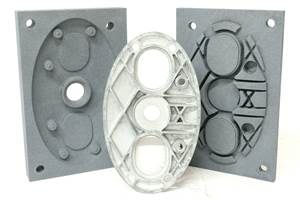“The constant challenge in additive manufacturing is that manufacturers are never sure if the powder is good enough to be reused,” says John Duffy, segment marketing manager at Malvern Panalytical. “But it’s beneficial to recycle it because it’s so expensive. You only ever use a small amount, maybe only 20% in a build.”
The remaining 80% or so of unfused powder may be perfectly reusable for many applications — the barrier to recycling is not so much the material quality as it is the ability to quickly measure and verify that quality.
Malvern Panalytical is one of several organizations that recently teamed up to prototype a solution to additive manufacturing’s powder recycling challenge. The company, which provides material analysis equipment used in a range of industries, integrated its laser diffraction tool with a sieving solution from Farleygreene and material hoppers and powder management software from Carpenter Additive. Dubbed “PowderCleanse,” the complete solution was conceived as a means of performing in-line powder inspection that can be completed during the standard powder sieving step.
Material Inspection During Sieving
The PowderCleanse workflow looks something like this: A PowderLife hopper from Carpenter Additive is connected to a Sievgen 04 sieve from Farleygreene. The powdered material is conveyed pneumatically into the sieve and processed as usual while Malvern Panalytical’s Insitec unit simultaneously measures the particle size distribution via laser diffraction; as the powder particles fall through the sieve, laser light shining through creates a distinctive scatter pattern that indicates the size of the particles.
The PowderCleanse system consists of PowderLife material hoppers and software from Carpenter Additive; a Sievgen sieve from Farleygreene; and the Insitec unit and analysis software from Malvern Panalytical. Image Credit: Malvern Panalytical
The technology allows for the detection of both fine and oversized particles that may have made it through sieving; too many of either extreme particle size might indicate something amiss in the 3D printing process that deserves attention. The primary purpose of the laser diffraction, however, is to characterize the powder properties and provide assurance that the material that passes this step is “clean” and can be trusted. Analyzed powder is then conveyed directly into a new waiting hopper, ready to be used again. The analysis step is controlled by Malvern Panalytical’s Link2 software; traceability data about the material’s oxygen content, moisture, chemical makeup and particle size distribution is recorded through Carpenter’s PowderTrace software.
While virtually all metal additive manufacturers working with powder perform some type of analysis on their materials, the distinctive feature of the PowderCleanse solution is that recycling and analysis can happen directly on the production floor. The system is fully enclosed, which protects operators as well as preventing the powder from being exposed to excess oxygen or moisture in the course of the recycling and sieving process.
It also means that powder characterization doesn't have to happen in a separate lab elsewhere in the building or possibly off-site; keeping analysis and recycling on the manufacturing floor saves time that might otherwise be wasted waiting for results. And while the sieving step was slowed in testing of the prototype to enable nearly 100% inspection of the powder, for applications requiring less than 100% inspection, users could manipulate the throughput to suit their needs.
A Modular Solution
PowderCleanse was developed as an integration project, Duffy says, with testing conducted by the Manufacturing Technology Centre (MTC) in the UK. The system was tested for its accuracy and efficacy in measuring powder, as well as various factors related to usability (including safety, ease to learn and memorability for operators). The solution was declared a success, though it has yet to be tested on a production facility floor.
“The goal was to develop a concept and prove it out,” Duffy says. While PowderCleanse is not being sold or marketed as a standalone product, “It was always meant to be modular, and each component is commercially available.” Malvern Panalytical’s integration team is available to help create customized solutions for interested clients working alongside the other project partners. Other types of analysis could be incorporated into such as system as well, for instance chemical analysis.
Related Content
Foundry Lab: How Casting in a Day Will Improve the Design of Metal Parts (Includes Video)
The company’s digital casting process uses 3D printing, but the result is a cast part. By providing a casting faster than a foundry, the company says effective prototyping is now possible for cast parts, as well as bridge production.
Read MoreComplete Speaker Lineup Announced for the 3D Printing Workshop at NPE2024: The Plastics Show
Presentations will cover 3D printing for mold tooling, material innovation, product development, bridge production and full-scale, high-volume additive manufacturing.
Read More4 Ways Augmented Reality and 3D Printing Intersect
Augmented reality (AR) is bringing benefits to additive manufacturing, and vice-versa.
Read MoreHow to Build 10,000+ Shot Molds in Hours
Rapid tooling isn’t so rapid when it takes days to 3D print a metal mold, and then you still must machine it to reach the necessary tolerances. With Nexa3D’s polymer process you can print a mold in hours that is prototype or production ready and can last for more than 10,000 shots.
Read MoreRead Next
GE Additive Rebrands as Colibrium Additive
As part of the brand name transition, both the Concept Laser and Arcam EBM legacy brands will be retired.
Read More3D Printing Brings Sustainability, Accessibility to Glass Manufacturing
Australian startup Maple Glass Printing has developed a process for extruding glass into artwork, lab implements and architectural elements. Along the way, the company has also found more efficient ways of recycling this material.
Read MoreTo Improve Performance of Compression Molded Composites, Add 3D Printed Preforms
9T Labs' Additive Fusion Technology enables the manufacture of composite structures with as much or as little reinforcement as is necessary, using 3D printed continuous fiber preforms to add strength just where needed.
Read More

.jpg;width=70;height=70;mode=crop)














.png;maxWidth=300;quality=90)










